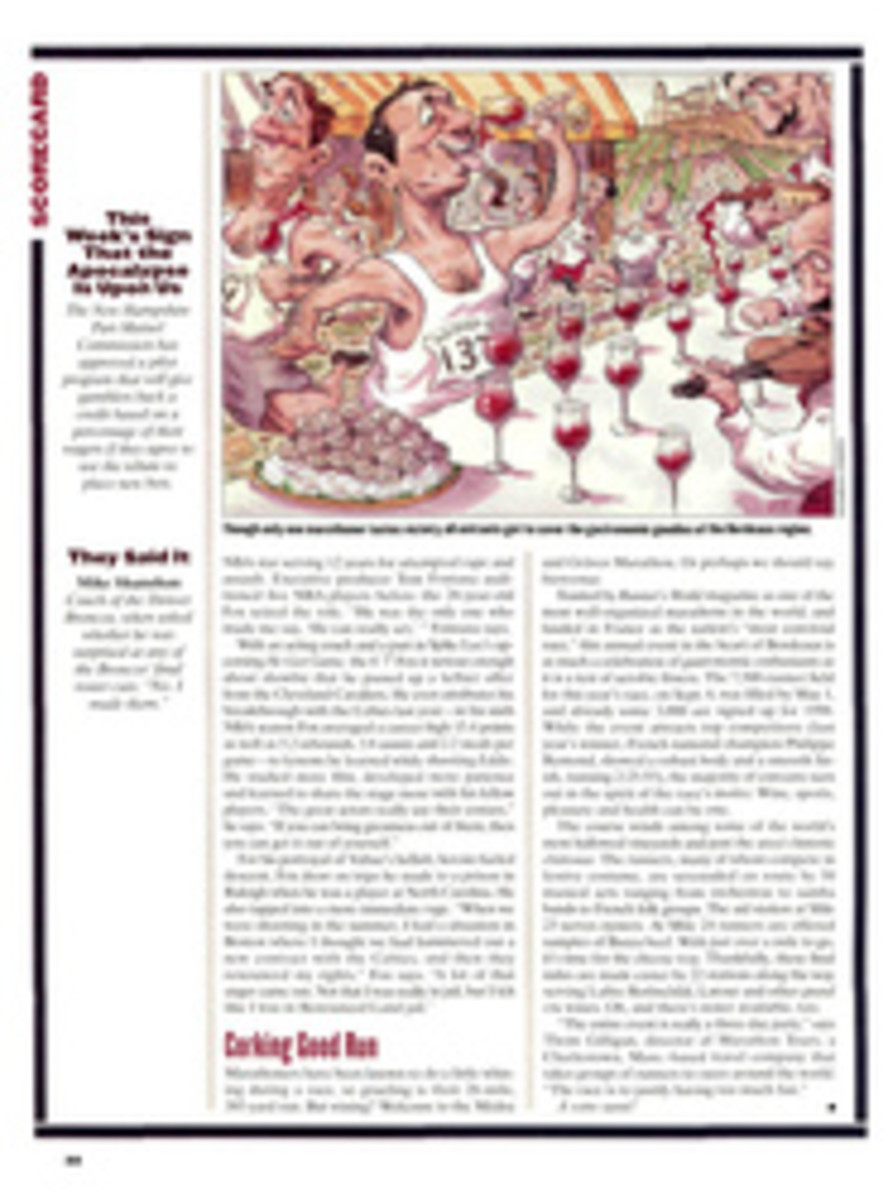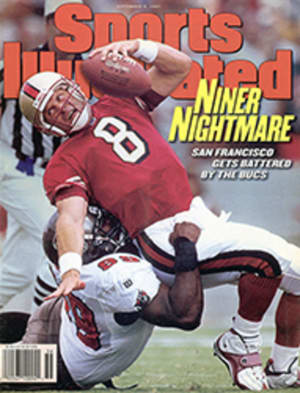
A SITE FOR SORE KNEES HOBBLED, UNINSURED EX-ATHLETES FIND HELP IN THE HANDS OF DR. JAMES ST. VILLE
There's a striking bronze in Dr. James St. Ville's conference
room: a rugby player diving headlong for the ball, his face
twisted, a tackler at his heels. Without clues of trajectory or
speed, it's tough to figure out whether that eternal athlete
will connect with the ball or just tumble empty-handed to the
turf. But for St. Ville the better question might be which
ligaments, muscles and bones could be pulverized either way.
That's a topic the 40-year-old doctor knows like a scalpel's
business end. St. Ville, a soft-spoken orthopedic surgeon, gives
generously of his time and skill to repair men who sacrificed
their bodies for peanuts and now can't tie their shoes. For four
years he has been performing rehabilitative surgery on former
professional athletes who are hobbled by the wear and tear they
endured in their playing days.
Their ranks include Pro Football Hall of Famers such as Dick
(Night Train) Lane (arthritic shoulder), Gene Upshaw (torn knee
cartilage) and many others whose names never became household
words. Some are surprisingly young. Many are crippled, a few are
forced to live as recluses because they are immobile, and more
often than not they are unable to obtain health insurance
because of their injuries.
That's where St. Ville comes in. Through his National Football
League Players Association Charity Surgery Program, and with the
help of John C. Lincoln-Deer Valley General Hospital in Phoenix,
where he is the head of orthopedic surgery, he has treated
nearly 150 former pro football and baseball players, regardless
of their ability to pay. Some, like Upshaw, have insurance that
covers their operations. St. Ville puts that money into an
endowment he has created for uninsured players.
"A lot of these guys were just forgotten when they left the
leagues," St. Ville says. "Some of them ended up destitute. Or
if not, maybe they can't even get out of the house. What I try
to do is help them get back in the act, to enjoy the kind of
life we all take for granted, even little things like playing
with their children."
Walt Cudzik is a walking case in point. The former center for
the Buffalo Bills, who retired from football in 1965 with two
blown knees and became a lawyer in '67, lived in pain for three
decades. "I used to get around O.K.," says the 65-year-old
Cudzik, who retired from his second career last year. "Then it
got to where I had to find things to hold on to from point to
point. Lord, the pain was unbelievable, and I couldn't get any
insurance."
After learning about St. Ville in 1992, Cudzik traveled from his
home in New Orleans to Phoenix for treatment. He considers that
trip a lifesaver. "Dr. St. Ville doesn't pick and choose who
he'll treat," says Cudzik, who was suffering from traumatic
osteoarthritis in both knees. St. Ville replaced both knees, and
Cudzik now gets around without pain, walking a mile a day and
swimming and playing golf regularly. His hospitalization would
have cost anywhere from $60,000 to $80,000, but most of that was
absorbed by St. Ville and by the NFLPA Charity Surgery Program.
Back in 1991 St. Ville was approached by former Baltimore Colts
defensive back Ron Gardin. "I was having elbow problems," says
the 53-year-old Gardin, "and a friend suggested I talk to Jim. I
told him my problem had been chronic since I played pro
football, and I assumed that most players leaving the game had
afflictions."
Gardin was president of the Phoenix chapter of the NFLPA at the
time, and, he recalls, "So many of those guys came limping into
the meetings." Many of their chronic conditions took years to
appear, long after the injuries healed. "Let's face it, when
most people think about athletes these days, they think about
the glamour and money," Gardin says. "But for every Joe Montana
there are hundreds of no-names like myself no one remembers."
Gardin and St. Ville started talking and came up with the
charity program, putting together a plan to take care of the
former athletes under the auspices of the NFLPA.
In the spring of 1996 St. Ville expanded his network to include
baseball players in a fledgling program spearheaded in part by
Hall of Famer Harmon Killebrew. "I think it's great what Jim is
doing," says Killebrew. "It's obvious that a lot of these
fellows wouldn't be getting treatment otherwise."
Robert Stirewalt, director of communications for the Major
League Baseball Players Alumni, calls the program "a big bonus
for us. Now we have a weekly section in our newsletter devoted
to those kinds of services."
St. Ville's repairs follow common themes, with knee and shoulder
surgeries most prevalent among the NFL vets. John Watson, an
Oklahoma tackle who went on to play for the San Francisco 49ers
(1971-76) and New Orleans Saints ('77-79), has recently had both
knees replaced by St. Ville. He is not alone. "At least 20 of
them have had total knee replacements, and some have had their
hips replaced as well," St. Ville says of the former football
players. "Even the younger guys often need knee-straightening
procedures. A lot of them don't have much of a knee joint left
when they leave the game, especially after six or seven
operations, when arthritis starts eating away at it."
Rotator cuff injuries are common among former baseball players,
according to St. Ville, with arthritis again being the
predominant affliction.
Most of the operations cost upward of $40,000, but even
relatively minor treatment can cost $10,000. St. Ville estimates
that his program has performed about $2.7 million in services
since it started.
The Johns Hopkins-trained doctor traces his interest in helping
former athletes back to his days as an all-state high school
running back in Tulsa. "Then, after I started practicing
medicine, a lot of my heroes started retiring, and I got to know
some of them personally," he says. "When I treated Ron, he began
mapping out the problems for the retirees, and I found out that
when a lot of them leave the NFL and their league coverage runs
out, they can't get their arms and legs reinsured. I would run
into guys who were 30 years old and couldn't get health
insurance."
Baseball, by contrast, does extend insurance to retired players,
but only if they can afford it. "Most of them never made big
money," St. Ville says. "Some were paid as little as $3,000 a
year, and pension plans were minimal."
The NFLPA helps offset medical costs through fund-raisers, and
Killebrew's baseball program is also gaining speed. In 1986 Joe
Garagiola helped establish the Baseball Assistance Team (BAT),
which extends financial help to needy ex-players and their
families. Garagiola, who also resides in the Phoenix area, says
BAT has yet to work with St. Ville directly. "But we may need
help in that way in the future. We think what he's doing is a
great thing."
Even big business has stepped forward, with Nautilus donating
weight machines, York donating free weights and Wave and
Ferno-Ille contributing rehab equipment to the charity clinic.
Conspicuously missing from the donor lists are current football
and baseball players. "I think they live in a rarefied world,"
says St. Ville. "What they don't realize is that often the way
they're going to leave the game is through serious injury."
Frank Woschitz, NFLPA director of retired players, agrees.
"Right now they think they're invincible," he says. "But when
they leave the game, they might find out how much they need [the
charity program]. They may not be destitute, but if they have a
catastrophic injury, where are they going to get the money to
take care of it?"
Also missing is the NFL itself, and St. Ville offers his own
theory on why. "If the league participated, it would be an
admission of guilt, an admission that there's been no support
from the league and club owners, even though they've seen how
this program has changed players," he says.
Gardin says, "There are so many lawsuits right now between the
teams and players that it has become a political football. We're
trying to make the league understand that this is nobody's
fault--it goes with the game. But we're also trying to get the
NFL to recognize the need."
That recognition may soon come. In 1993 the league extended
postcareer paid insurance coverage to two years, up from the
former 18 months, and grandfathered pre-1959 players into the
current retirement program. Still, NFL financial support for
charity work like St. Ville's remains little more than a goal,
he says. "We have to negotiate some of these things with the
NFL, and to date they don't get involved with it."
"The way to introduce that would be for the NFLPA to raise it in
the context of the collective bargaining agreement," says John
Jones, the manager of labor administration for the NFL
Management Council. "League representatives would be ready to
consider whatever the NFLPA puts forward, but they haven't
introduced that yet."
Meanwhile, the NFLPA is trying to find a company willing to
insure its members as a group, Woschitz says. "We're told they
are high risks. We've talked to at least 30 companies, and none
would do it."
That's why the work of St. Ville and an expanding cadre of donor
hospitals like his is crucial. The list of Good Samaritans now
includes, among others, Deborah Heart and Lung Center in Browns
Mills, N.J.; Kendrick Memorial Hospital in Mooresville, Ind.;
Jim Thorpe Rehabilitation Hospital in Oklahoma City; and
Allegheny General Hospital in Pittsburgh.
Woschitz calls the outpouring of support heartwarming, but he
singles out St. Ville for his devotion. "What he's doing is just
the right thing," Woschitz says.
Regardless of who coughs up the cash and who can't, St. Ville
says his reward comes in lifting former warriors back onto their
feet. "You get to see these guys turn their lives around," he
says. "You can't imagine the impact it has on them."
Tim Vanderpool, a freelancer who lives in Tucson, has also
written for Outside and the Utne Reader.
COLOR PHOTO: SCOTT TROYANOS It looks like shop class, but it's St. Ville putting in a new knee. [James St. Ville performing knee operation]
COLOR PHOTO: SCOTT TROYANOS Thanks to St. Ville (right), Watson is fully ambulatory again. [John Watson and James St. Ville]

